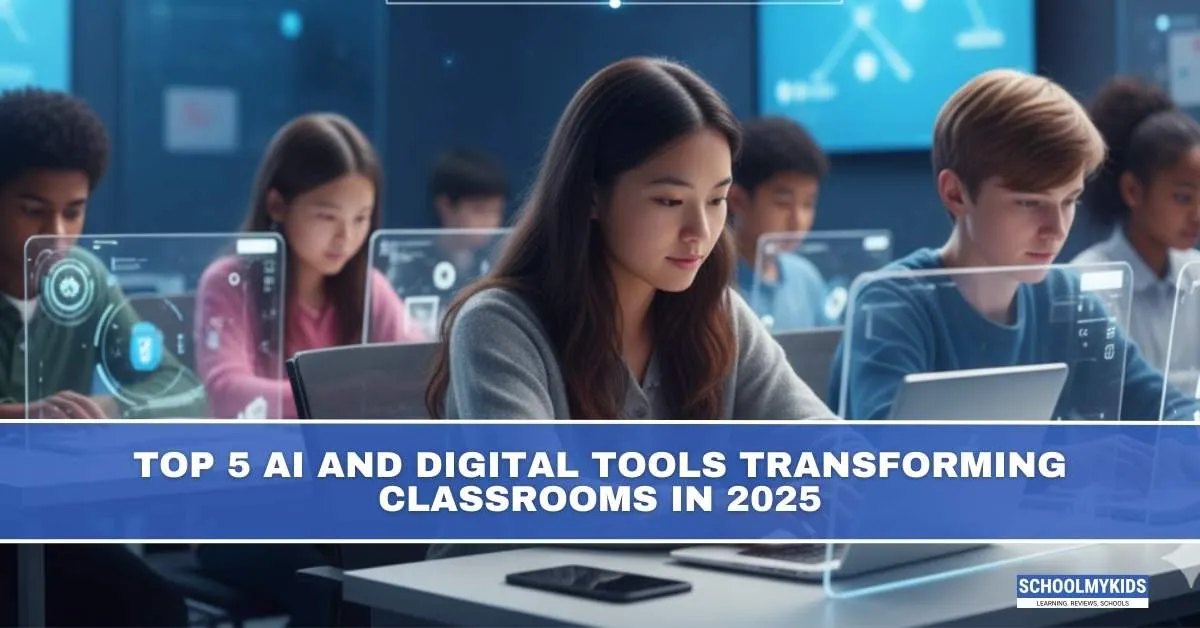Education in 2025 doesn’t look like the classrooms many parents grew up in. Chalkboards and static lectures are giving way to AI tutors, immersive simulations, and digital learning ecosystems that put students at the center of the experience. Technology is no longer an add-on; it’s embedded into teaching and learning itself.
Here are the top five AI and digital tools reshaping classrooms in 2025—and what they mean for teachers and students.
#1. AI-Powered Personal Tutors
Every student learns differently. Some need extra time on algebra, while others grasp it instantly but struggle with essays. In 2025, AI-powered tutors act like personal learning assistants, analyzing a student’s strengths, weaknesses, and pace.
- How it works: These tools track progress in real time, recommend practice questions, and offer hints when a student is stuck.
- Impact on students: They get personalized attention without waiting for the teacher to finish with others.
- Impact on teachers: Freed from repetitive tasks, teachers can focus on mentoring and creative instruction.
Tools like this have made learning adaptive rather than one-size-fits-all.
#2. Immersive Virtual and Augmented Reality Labs
Instead of reading about chemical reactions or space exploration, students now step inside them through VR and AR.
- Chemistry labs: Students perform virtual experiments without needing expensive or dangerous chemicals.
- Biology and medicine: VR lets learners explore human anatomy in 3D, zooming in on organs and cells.
- History and geography: AR brings historical events or landscapes into classrooms, making abstract concepts vivid.
These labs are especially transformative in rural or underfunded schools, where real labs are rare. A laptop or headset is enough to give every student a hands-on experience.
#3. Real-Time Language Translation and Support
Language is no longer a barrier in global classrooms. AI-driven translation tools in 2025 provide:
- Live captions and translations during lectures.
- Text-to-speech features for students with learning difficulties.
- Seamless collaboration between students from different countries.
This has opened up international exchange programs online, where an Indian student can discuss climate policy with a peer in Brazil—without worrying about language gaps. Inclusivity has gone from theory to practice.
#4. Adaptive Assessment Platforms
Exams used to be stressful, rigid events that measured memory more than skills. Adaptive assessment platforms in 2025 are smarter.
- Dynamic testing: Questions adjust in difficulty based on the student’s responses.
- Instant feedback: Instead of waiting weeks for results, students get performance reports immediately.
- Skill mapping: These systems highlight not only what the student got wrong, but why, and how to improve.
For teachers, this means less time grading and more time interpreting results to guide instruction. For students, it reduces the fear of exams by making them part of learning, not just judgment.
#5. Collaborative Digital Classrooms
The classroom has broken free of four walls. Platforms now integrate video conferencing, AI-driven moderation, shared digital whiteboards, and project management tools.
- Group projects: Students collaborate across cities or countries in real time.
- Teacher dashboards: AI summarizes participation and contributions, ensuring fair grading.
- Community learning: Guest lectures and expert talks are easily integrated into regular lessons.
This hybrid model—physical plus digital—has become the new norm. It ensures flexibility while preserving human connection.
Benefits of These Tools
- Personalization: Learning paths adapt to each student.
- Engagement: Gamified and immersive experiences keep students motivated.
- Equity: Rural and urban students access the same quality resources.
- Efficiency: Teachers save time on grading and admin work.
- Global Outlook: Students collaborate across borders and cultures.
Challenges and Concerns
- Screen Fatigue: More digital tools mean managing students’ screen time wisely.
- Digital Divide: Not every region has the bandwidth or devices to support these tools.
- Over-Reliance on AI: Students must learn critical thinking, not just accept AI outputs blindly.
- Teacher Training: Without adequate training, tools risk being underused or misused.
Technology is powerful, but its success depends on how well schools integrate it with pedagogy.
The Human Role in a Tech-Driven Classroom
Even with all the AI and digital tools, the teacher’s role hasn’t diminished—it has evolved. Teachers in 2025 are less about delivering content and more about:
- Guiding ethical use of technology.
- Encouraging curiosity and creativity.
- Acting as mentors who connect learning to real-world contexts.
AI handles the mechanics of instruction, but only humans can nurture empathy, resilience, and imagination.
Conclusion
The classrooms of 2025 look dramatically different from a decade ago. AI tutors, immersive labs, translation tools, adaptive assessments, and collaborative platforms are not science fiction—they’re everyday reality. For students, these tools mean a more personalized, inclusive, and engaging education. For teachers, they provide freedom to focus on what matters most: inspiring learners.
Education’s future is not about replacing humans with technology—it’s about using technology to make education more human.









Be the first one to comment on this story.